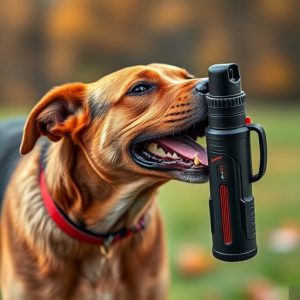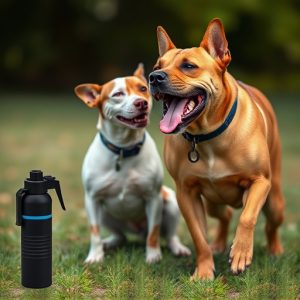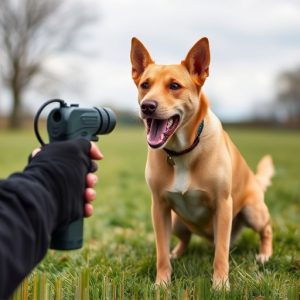Dog Pepper Spray: Safety, Legalities, and Effective Use Strategies
Dog pepper spray offers a controversial yet life-saving solution for dealing with aggressive canines…….
Dog pepper spray offers a controversial yet life-saving solution for dealing with aggressive canines, providing temporary incapacitation. Its use is banned in many states due to animal welfare concerns and potential misuse. Responsible deployment requires understanding the spray's range, effectiveness, and limitations, following safety precautions, securing storage, and knowing local laws. Before considering it, explore legal alternatives like positive reinforcement training or professional behavioral modification programs. Always check state restrictions, as some regions prohibit dog pepper spray entirely.
“In the realm of canine behavior management, understanding and addressing aggression is paramount. This article delves into an often-overlooked tool: dog pepper spray. We explore its benefits and safety precautions, particularly in light of legal considerations for restricted states. With a focus on responsible ownership, we guide you through choosing the right product and training strategies to ensure effective yet safe use of dog pepper spray. Remember that knowledge is key; learn how this can help navigate challenging situations with your canine companion.”
- Understanding Dog Pepper Spray: Benefits and Safety Precautions
- Legal Considerations: Dog Pepper Spray in Restricted States
- Choosing the Right Product: Factors to Consider for Effective Use
- Training and Implementation: Responsible Use Strategies for Dog Owners
Understanding Dog Pepper Spray: Benefits and Safety Precautions
Dog pepper spray is a controversial yet potentially life-saving tool for dealing with aggressive canine encounters. It’s designed to temporarily incapacitate a dog, providing time to escape or de-escalate a potentially dangerous situation. Key benefits include their compact size, making them easily portable for walks or outdoor activities, and their non-lethal nature, which is crucial when facing unpredictable animals.
However, it’s essential to approach dog pepper spray with caution. They are banned in several Dog Pepper Spray Restricted States due to concerns about misuse and animal cruelty. Responsible use requires understanding the spray’s range, effectiveness, and limitations. Always follow safety precautions, store the spray securely out of reach of children and pets, and familiarize yourself with local laws regarding its possession and deployment.
Legal Considerations: Dog Pepper Spray in Restricted States
In many regions, using pepper spray on dogs is subject to stringent legal restrictions due to animal welfare concerns and potential misuse. While it can be a powerful tool for deterring aggressive canine behavior, its application is tightly controlled. Dog pepper spray is typically illegal in urban areas where strict animal protection laws are in place. Several states have specifically outlawed the use of pepper spray on animals, including dogs, as part of their efforts to prevent cruelty and ensure humane treatment.
Before considering dog pepper spray as an option for managing aggressive behavior, individuals must familiarize themselves with local legislation. In restricted states, alternative methods such as positive reinforcement training, shock collars, or professional behavioral modification programs are often encouraged as legal and ethical alternatives to chemical deterrents. Compliance with these regulations is not only a legal requirement but also demonstrates a commitment to responsible dog ownership and community safety.
Choosing the Right Product: Factors to Consider for Effective Use
When considering dog pepper spray, it’s crucial to choose a product tailored for aggressive canine behavior. Key factors include concentration and active ingredients, as well as the spray’s range and duration. Opt for a formula designed specifically for dogs, with higher capsaicin concentrations, typically 10% or more, to ensure effectiveness. Check state restrictions; dog pepper spray laws vary widely, with some states completely prohibiting its use. Always review local regulations before purchasing or using any type of pepper spray for dogs.
Additionally, consider the spray’s delivery mechanism and weather-appropriate design. A jet stream nozzle can increase range and accuracy, while a larger can offers better protection against wind and rain. Look for products with durable construction and childproof safety features to prevent accidental misuse. Regularly inspect the spray and ensure it remains fully charged or ready for use at all times.
Training and Implementation: Responsible Use Strategies for Dog Owners
Using pepper spray on aggressive dogs should be a last resort, and it’s crucial to understand its responsible implementation among dog owners. In many states across the US, dog pepper spray is legal for self-defense against aggressive or dangerous canines under specific circumstances. However, there are strict regulations governing its use, with several states restricting or prohibiting its sale without a license due to safety concerns and potential misuse.
Training plays a pivotal role in managing dog aggression effectively. Dog owners should prioritize positive reinforcement training methods to teach their pets basic commands and control their behavior. If aggression persists, consulting a professional dog trainer or behaviorist is advised. In some cases, when traditional training methods fail and the dog poses an imminent threat, pepper spray can be considered as a deterrent. But it’s essential to follow local laws and guidelines, ensuring safe storage and use to avoid accidental harm or excessive use on pets or bystanders, especially in restricted states.
While dog pepper spray offers potential benefits for managing aggressive canines, it’s crucial to approach its use responsibly. Understanding both the legal landscape in restricted states and the specific needs of your dog is essential. By choosing the right product and implementing training strategies, owners can utilize this tool effectively while prioritizing safety and ethical practices. Remember, responsible ownership includes finding solutions that work for both the dog and their community.


